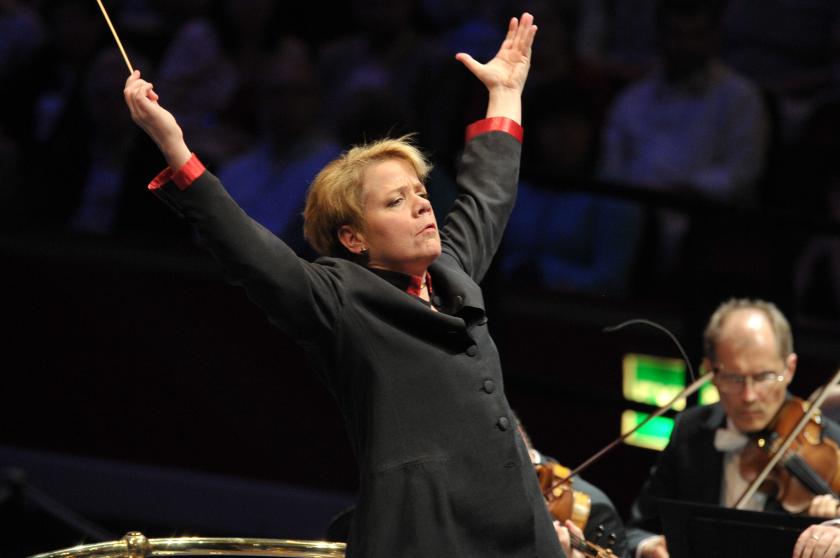It may be the power of suggestion, but there was distinctly laid-back vibe at the packed Royal Albert Hall last night. Clapping between movements (and this was an audience never knowingly under-clapped) wasn’t greeted by the any of the usual hisses, and when a latecomer clattered down the entire length of stalls steps before the Largo of Dvořák’s Symphony No 9 she drew only the most indulgent of laughter. The Brazilians had arrived, bringing with them a warmth that extended well beyond the stage.
It seems extraordinary that this should be the first visit of the São Paulo Symphony – one of South America’s most prominent orchestras – to the Proms, but novelty was the theme of an evening that also showcased the ensemble’s brand new Chief Conductor, Marin Alsop.
Alsop in full spate is a sight to behold
It’s a great pairing; the orchestra’s sound is as generous as Alsop’s gestures, with a string section that moves from silvery violins to Caravaggio-black basses, and the sheer heft of the band is more than a match for the conductor’s muscular style. The wind however still have a few issues, as quickly became apparent in Dvořák’s New World Symphony.
This is a big band, and Alsop used this to her advantage in drawing out the schizophrenic episodes of the first movement. But despite the wash of colours here there were just too many ragged edges to lose oneself in them. Entries were rarely together and tempos rushed and pulled constantly, with Alsop’s speeds apparently being treated as the basis for negotiation by the wind section. The biggest casualty of this was the Largo, whose English horn theme was both rushed and sour in intonation, never quite matching the propulsion Alsop generates from the orchestra with stillness and contemplation. The earthy Scherzo fared better, but overall this was a performance of blunt energy.
 Things improved in the second half with the pairing of Copland’s Fanfare for the Common Man and Joan Tower’s feminist riposte (dedicated to Alsop herself) Fanfare for the Uncommon Woman. Brass and timpani did their thing, swelling the over-excited crowd with rhythmic crispness, though the Copland felt again as though it was pulling ahead of the truly stately tempo this building can take.
Things improved in the second half with the pairing of Copland’s Fanfare for the Common Man and Joan Tower’s feminist riposte (dedicated to Alsop herself) Fanfare for the Uncommon Woman. Brass and timpani did their thing, swelling the over-excited crowd with rhythmic crispness, though the Copland felt again as though it was pulling ahead of the truly stately tempo this building can take.
Preamble over, we moved to the music of Brazil – the stuff we’d all really come to hear. Villa-Lobos’s Momoprecoce saw the orchestra joined by pianist Nelson Freire (pictured above), driving us through this phantasmagoric stroll through a Brazilian street carnival with authority and no little wit. The “little devil” was cheeky, the jester’s pipe coaxing and lyrical, and the wind finally came into their own in the angular bassoon solo that opens the “little ragman” episode.
While Villa-Lobos’s scenes flirt with the exotic, Ginastera’s Estancia is a full-on immersion in the South American rhythms of dance and life. It’s a gift of a piece for a festival like the Proms, capable of propelling a willing audience into ecstasies with its insistent rhythms. Alsop in full spate is a sight to behold, and here she made a virtue of her orchestra’s occasional raggedness, demanding the grounded, instinctual performance they were made to give. Orchestral balance wasn’t fussed over too much, and we did occasionally lose some of Ginastera’s details among the eager rush of sound, but it was a sacrifice worth making for the frankly sexual urgency of the closing Malambo.
Encores were demanded and delivered, and but for the terribly English bureaucracy of the Royal Albert Hall I’m sure the party would have continued even longer. In Alsop the São Paulo Symphony Orchestra have found precisely the conductor to develop their technique without losing those characteristic colours that give it its personality. Let’s hope the Proms invites them back again soon so we can hear what this partnership can really achieve together with a little time.















Add comment